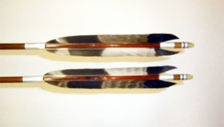Home > About KYUDO > Equipment・Clothing

Yumi (Bow)

Modern bows are mostly made using synthetic resins as a bonding agent. In the past only a natural glue called nibe was used. Nibe bows, which are still made today, have some merits that are highly rated, but these bows are weak to humidity and high temperatures. They are also apt to warp in the summer months or in the rainy season in Japan.
Consequently, one must protect the bow against moisture by wiping it with a dry cloth before and after use.
As it is unsightly to have kusune (resin) stains or dirt on the bow; one must take care to wipe it well with a dry cloth.
The strengths and weaknesses in the shape of the bow have a serious influence on its durability and capability that it demonstrates. To keep the proper strengths and weaknesses, it is important that in caring for the bow one must always consider the correctness of the shape.
Ya (Arrow)


Arrows also have little resistance to moisture. Therefore bamboo shafts that become warped will have to be straightened by tameru (heat). Arrows should always be kept in a dry place and wiped with a dry cloth after use to avoid accumulation of moisture and to remove any dirt. It is necessary to do this from time to time to keep the arrows in their proper shape.
Yugake (Glove)
There are three types: Mitsu-Gake (3 finger glove), Yotsu-Gake (4 finger glove), and Moro-Gake (5 finger glove). Gloves are difficult to use, and as each type has its own characteristics, it is better that beginners be taught how to use a glove correctly by a teacher.
A glove can be used for many years depending on how it is used and the cared for. Therefore, it is very important to treat a glove carefully and to know well the function and characteristics of the glove.
As gloves are formed from tanned hide that is glued and stitched into its final shape weak to moisture and should be kept in a dry place. When a glove becomes damp with sweat, it is advisable to dry it out in the shade with good ventilation. It should not be dried by direct sunlight or heat.
Tsuru (String)

Before and after shooting, it is important that the string is cared for by rubbing with a magusune (woven pad) so that through friction, the kusune (resin) applied on the string will melt and permeate into the string to make it stronger. The weight of a string is determined by the draw strength of the bow and the weight of arrows used. For example, a normal bow of 1.8 cm. in thickness with a draw weight of 22-23kg, and an arrow weight of 26-28g will require a suitable string weight of 7-7.5g.
Clothing
It is very important to use clothing which is suitable to the time, place and occasion. These may be wearing Wafuku (Kimono), or Kyudogi (Practice Clothing). The color of the tabi (Japanese socks) should be white, and other items should be clean and comply with the accepted standards of etiquette.
When shooting in Wafuku or Kyudogi (white is preferable), it is better that the hakama be a machidaka-bakama (trouser-type). It is not desirable for a male archer wearing Wafuku with a kamon (family crest) to wear western-style underwear, or a t-shirt underneath.








